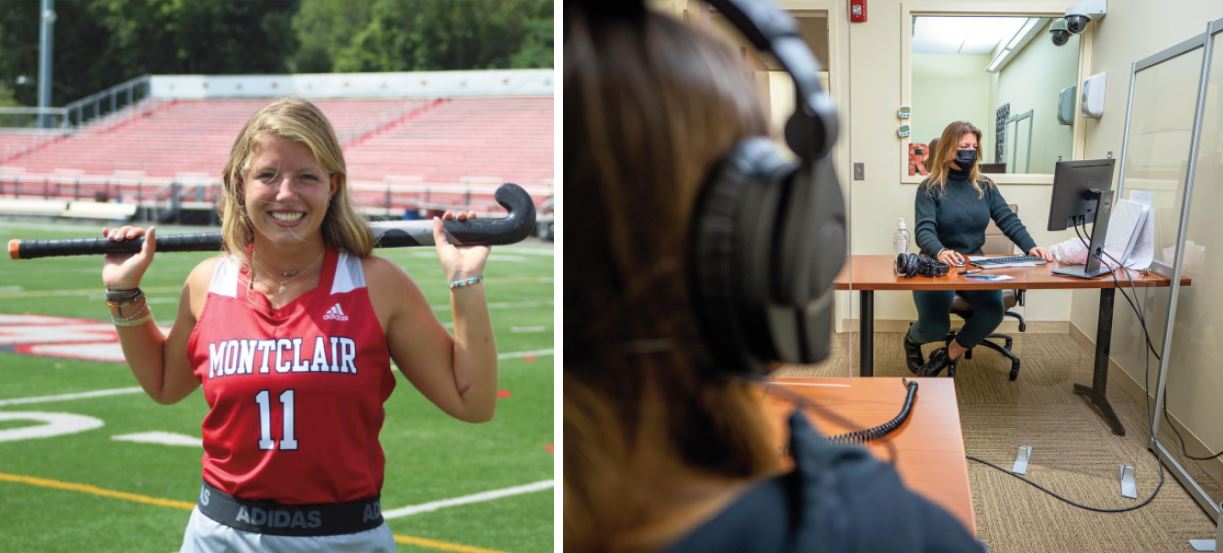
OUTSTANDING IN HER FIELDS: (Above left) Evyn played field hockey since she was old enough to hold a stick. Following their mom's lead, Evyn and her sister also played college-level hockey. (Above right) Evyn works with grad student Ashley Martino, a research participant in Stewart's independent study.
fered from ear infections, and had to have tubes put in her ears as a toddler to fourth grader. She did without them for a short period, but an ear infection led to a perforated eardrum in her left ear.
“That was the first of four perforations, and so I currently have a tube in my ear. I get it replaced every four years or so,” she says, joking that she’s going to have to find a “big girl ENT” soon. The tube, she explains, “stabilizes my eardrum and equalizes the pressure. There’s a bunch of scarring in my ear and on my Eustachian tube, and that’s what led to my unilateral conductive hearing loss.”
Stewart also has been playing field hockey since she could hold a stick, and was a member of Montclair’s field hockey team for four years. Her hearing loss, she says, was her biggest challenge on the field.
"Definitely I felt the impact in sports. I had a hard time telling directional sound. If I had a teammate on my left side, then I definitely had a harder time knowing if they were calling for the ball, but the other thing is, we weren't out on the field whispering, right?" she laughs. "They're [also] going to say my name."
"You could say I've been taking hearing classes for 21 years. I looked into the field more and shadowed my audiologist, and then volunteered in the biofeedback lab, too. All of that is why I wanted to go into audiology."
Indoor high school tournaments where fields were side by side were “doubly hard,” she says. She could not tell if a whistle was blown by a referee on her field or nearby. At the advice of a mom who recognized her confusion, because her daughter also had hearing loss, Stewart bought some whistles that sound like train whistles.
“I would give those to the refs if I knew that we were going to be in a complex with multiple fields next to each other, and so that was helpful,” she says.
In some ways, Stewart thinks she's developed other skills to compensate and learned to adapt.
"I have definitely done different things and just became accustomed to different methods," she explains. "So, my game sense is huge for me, just knowing, predicting where the ball would end up, and what play would happen, versus where it is. That's how, directionally, I would get myself situated. And I definitely don't think I would have that aspect, if I didn't become so dependent on it."
INDEPENDENT STUDY
Stewart was on track to become a speech pathologist, however a summer course in audiology, volunteering in the lab, and her independent study, changed her career trajectory. The way she sees it, her hearing loss has immersed her in the field of audiology.
"You could say I've been taking hearing classes for 21 years," she says, smiling, "but it never really hit me as a profession, until that class. And then, I had an ENT appointment that summer, and I talked to my audiologist who has been doing my hearing tests since I was pretty young. My favorite part of going to the ENT was the hearing test, because they're not poking and prodding in your ear. I looked into it more and shadowed my audiologist, and then volunteering in the biofeedback lab, too. All of that is why I wanted to go into audiology."
University faculty and staff helped Stewart achieve her goal of an independent study, a hurdle that required lots of research, work and persistence to gain registrar approval, since she was an undergrad and not a graduate student. Adjunct Professor of Communication Sciences and Disorders, Laura Ochs recommended the volunteer opportunity and Stewart worked closely with and assisted Michelle Turner, a speech-language pathology (SLP) doctoral student with whom she was paired, with research prior to her independent study.